STL源码剖析 — 空间配置器(allocator)
前言
以STL的实现角度而言,第一个需要介绍的就是空间配置器,因为整个STL的操作对象都存放在容器之中。
你完全可以实现一个直接向硬件存取空间的allocator。
下面介绍的是SGI STL提供的配置器,配置的对象,是内存。(以下内容来自《STL源码剖析》)
引子
因为这篇写得太长,断断续续都有几天,所以先在这里整理一下思路。
- 首先,介绍 allocator 的标准接口,除了拥有一些基本的typedef之外,最重要的就是内存相关的 allocate 和 deallocate;构造相关的 construct 和 destroy。(两者分离)然后就是实现一个简单的配置器,没有内存管理,只是简单的malloc。
- allocate 和 deallocate 负责获取可以用的内存。
- construct调用placement new构造函数,destroy调用相应类型的析构函数 ~T()。
- 然后介绍了SGI的第一级和第二级配置器。定义__USE_MALLOC可以设置使用第一级配置器还是两个都用。
- 内存池保留没有被分配到free list的空间,free list维护一张可供调用的空间链表。
- construct 会使用placement new构造,destroy借助traits机制判断是否为 trivial再决定下一步动作。
- allocate调用refill函数,会缺省申请20个区块,一个返回,19个留在free list。refill又有三种情况。
- deallocate先判断是否大于128byte,是则调用第一级配置器,否就返回给freelist。
空间配置器的标准接口
根据STL的规范,allocator的必要接口
- 各种typedef
1 allocator::value_type 2 allocator::pointer 3 allocator::const_pointer 4 allocator::reference 5 allocator::const_reference 6 allocator::size_type 7 allocator::difference_type 8 allocator::rebind // class rebind<U>拥有唯一成员other;是一个typedef,代表allocator<U>
- 默认构造函数和析构函数,因为没有数据成员,所以不需要初始化,但是必须被定义
1 allocator::allocator() 2 allocator::allocator(const allocator&) 3 template <class U> allocator::allocator(const allocator<U>&) 4 allocator::~allocator()
- 初始化,地址相关函数
1 // 配置空间,足以存储n个T对象,第二个参数是提示,能增进区域性 2 pointer allocator::allocate(size_type n, const void*=0) 3 4 size_type allocator::max_size() const 5 6 pointer allocator::address(reference x) const 7 const_pointer allocator::address(const_reference x) const
- 构建函数
1 void allocator::construct(pointer p, const T& x) 2 void allocator::destory(pointer p)
自己设计一个简单的空间配置器
1 #ifndef __VIGGO__ 2 #define __VIGGO__ 3 #include <new> // for placement new 4 #include <cstddef> // for ptrdiff_t, size_t 5 #include <cstdlib> // for exit() 6 #include <climits> // for UINT_MAX 7 #include <iostream> // for cerr 8 9 namespace VG { 10 11 template <class T> 12 inline T* _allocate(ptrdiff_t n, T*) { 13 set_new_handler(0); 14 T* tmp = (T*)(::operator new((size_t)(n * sizeof(T)))); 15 if (tmp == 0) { 16 cerr << "alloc memory error!" << endl; 17 exit(1); 18 } 19 return tmp; 20 } 21 22 template <class T> 23 inline void _deallocate(T* p) { 24 ::operator delete(p); 25 } 26 27 template <class T1, class T2> 28 inline void _construct(T1* p, const T2& value) { 29 new(p) T1(value); 30 } 31 32 template <class T> 33 inline void _destroy(T* p) { 34 p->~T(); 35 } 36 37 template <class T> 38 class allocator { 39 public: 40 typedef T value_type; 41 typedef T* pointer; 42 typedef const T* const_pointer; 43 typedef T& reference; 44 typedef const T& const_reference; 45 typedef size_t size_type; 46 typedef ptrdiff_t difference_type; 47 48 template <class U> 49 struct rebind { 50 typedef allocator<U> other; 51 }; 52 53 pointer address(reference x) {return (pointer)&x;} 54 const_pointer address(const_reference x) const { 55 return (const_pointer)&x; 56 } 57 58 pointer allocate(size_type n, const void *hint=0) { 59 return _allocate((difference_type)n, (pointer)0); // mark 60 } 61 62 void deallocate(pointer p, size_type n) { 63 _deallocate(p); 64 } 65 66 size_type max_size() const {return size_type(UINT_MAX / sizeof(T));} 67 68 void construct(pointer p, const T& x) { 69 _construct(p, x); 70 } 71 72 void destroy(pointer p) { 73 _destroy(p); 74 } 75 }; 76 } 77 #endif
放在 vector<int, VG::allocator<int> > 中测试,可以实现简单的内存分配,但是实际上的 allocator 要比这个复杂。
SGI特殊的空间配置器
标准的allocator只是基层内存配置/释放行为(::operator new 和 ::operator delete)的一层薄薄的包装,并没有任何效率上的强化。
现在我们看看C++内存配置和释放是怎样做的:
new运算分两阶段(1)调用 ::operator new 配置内存;(2) 调用对象构造函数构造对象内容。
delete运算也分两阶段(1) 调用对象的析构函数;(2)调用 ::operator delete 释放内存。
为了精密分工,STL allocator决定将两阶段操作区分开来,内存配置由 alloc::allocate() 负责。内存释放操作由 alloc::deallocate()负责;对象构造由 ::construct() 负责,对象析构由 ::destroy() 负责。
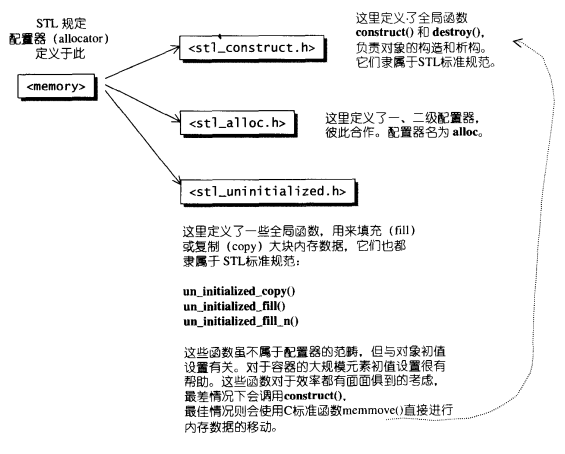
构造和析构基本工具:construct() 和 destroy()
construct() 接受一个指针p和一个初值value,该函数的用途就是将初值设定到指针所指的空间上。C++的placement new运算子可用来完成这一任务。
destory()有两个版本,一是接受一个指针,直接调用该对象的析构函数即可。另外一个接受first和last,将半开范围内的所有对象析构。首先我们不知道范围有多大,万一很大,而每个对象的析构函数都无关痛痒(所谓 trivial destructor),那么一次次调用这些无关痛痒的析构函数是一种浪费。所以我们首先判断迭代器所指对象是否为 trivial(无意义), 是则什么都不用做;否则一个个调用析构。

上图为construct的实现函数
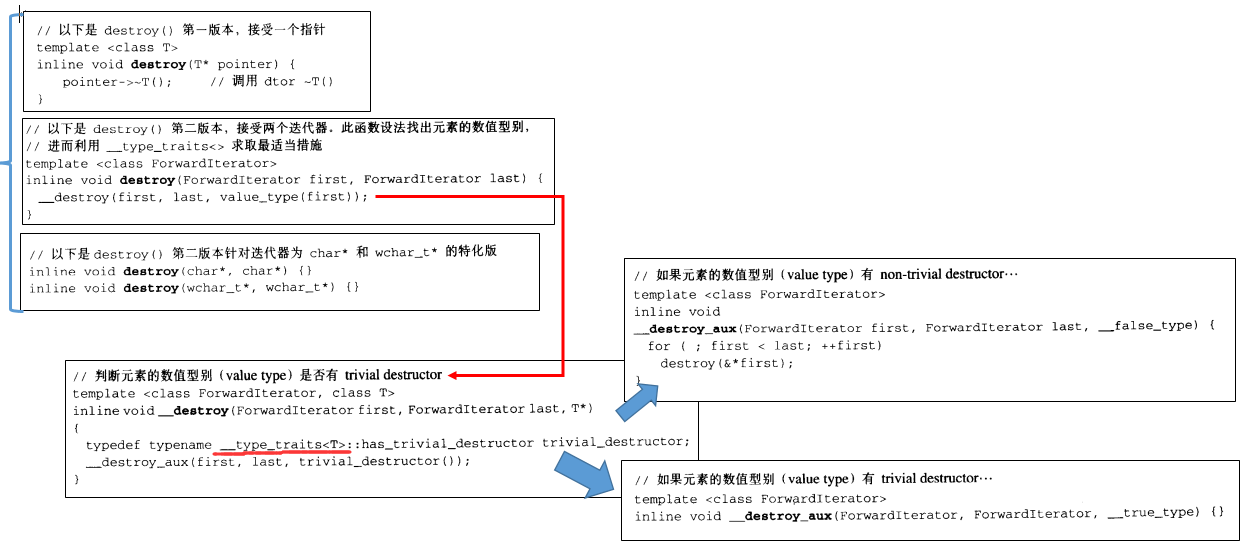
上图为destroy的实现函数
这里用到我们神奇的 __type_traits<T>,之前介绍的 traits 是 萃取返回值类型 和 作为重载依据的,现在为每一个内置类型特化声明一些tag。

现在我们需要用到 真 和 假 两个标志:

示例:
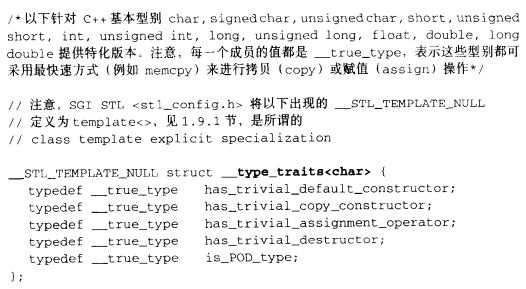
空间的配置和释放:std::alloc
SGI的设计哲学: 1. 向 system heap 要求空间; 2. 考虑多线程状态(先略过);3. 考虑内存不足时的应变措施;4. 考虑过多“小型区块”可能造成的内存碎片问题。
SGI设计了双层级配置器,第一级配置器直接使用 malloc() 和 free(),第二级配置器则视情况采用不同的策略;当配置区块超过128bytes时,交给第一级配置器。
整个设计究竟只开放第一级配置器,或是同时开放第二级配置,取决于__USE_MALLOC时候被定义:
1 # ifdef __USE_MALLOC 2 ... 3 typedef __malloc_alloc_template<0> malloc_alloc; 4 typedef malloc_alloc alloc; // 令alloc为第一级配置器 5 #else 6 ... 7 // 令alloc为第二级配置器 8 typedef __default_alloc_template<__NODE_ALLOCATOR_THREADS, 0>alloc; 9 #endif
其中__malloc_alloc_template就是第一级配置器,__default_alloc_template为第二级配置器。alloc并不接受任何template型别参数。
无论alloc被定义为第一级或第二级配置器,SGI还为它在包装一个接口如下,使配置器的接口能够符合STL规格:
1 template <class T, class Alloc> 2 class simple_alloc { 3 public: 4 static T *allocate(size_t n) 5 {return 0==n? 0 : (T*)Alloc::allocate(n * sizeof(T));} 6 static T *allocate(void) 7 {return (T*)Alloc::allocate(sizeof(T));} 8 static void deallocate(T *p, size_t n) 9 {if (0 != n) Alloc::deallocate(p, n*sizeof(T));} 10 static void deallocate(T *p) 11 {Alloc::deallocate(p, sizeof(T));}
一二级配置器的关系,接口包装,及实际运用方式,
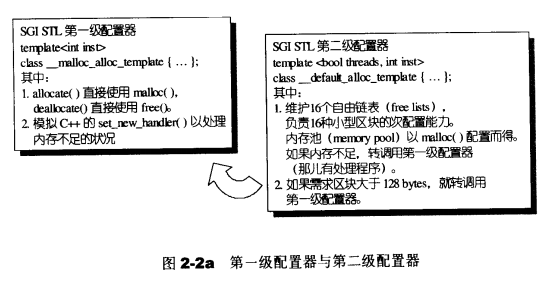
第一级配置器 __malloc_alloc_template
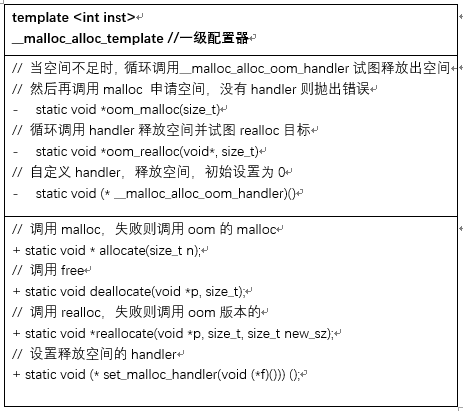
1 #if 0 2 # include <new> 3 # define __THROW_BAD_ALLOC throw bad_alloc 4 #elif !defined(__THROW_BAD_ALLOC) 5 # include <iostream> 6 # define __THROW_BAD_ALLOC cerr << "out of memery" << endl; exit(1); 7 #endif 8 9 // malloc-based allocator.通常比稍后介绍的 default alloc 速度慢 10 // 一般而言是thread-safe,并且对于空间的运用比较高效 11 // 以下是第一级配置器 12 // 注意,无“template型别参数”。置于“非型别参数”inst,则完全没排上用场 13 template <int inst> 14 class __malloc_alloc_template { 15 private: 16 //以下都是函数指针,所代表的函数将用来处理内存不足的情况 17 static void *oom_malloc(size_t); 18 static void *oom_realloc(void*, size_t); 19 static void (* __malloc_alloc_oom_handler)(); 20 public: 21 static void * allocate(size_t n) { 22 void *result = malloc(n); // 第一级配置器直接使用malloc 23 // 无法满足需求时,改用oom_malloc 24 if (0 == result) result = oom_malloc(n); 25 return result; 26 } 27 28 static void deallocate(void *p, size_t /* n */) { 29 free(p); // 第一级配置器直接用free() 30 } 31 32 static void * reallocate(void *p, size_t /* old_sz */, size_t new_sz) { 33 void *result = realloc(p, new_sz); 34 if (0 == result) result = oom_realloc(p, new_sz); 35 return result; 36 } 37 38 // 以下仿真C++的 set_handler()。换句话,你可以通过它 39 // 指定自己的 out-of-memory handler,企图释放内存 40 // 因为没有调用 new,所以不能用 set_new_handler 41 static void (* set_malloc_handler(void (*f)())) () { 42 void (*old)() = __malloc_alloc_oom_handler; 43 __malloc_alloc_oom_handler = f; 44 return old; 45 } 46 }; 47 48 // 初值为0,待定 49 template <int inst> 50 void (* __malloc_alloc_template<inst>::__malloc_alloc_oom_handler)() = 0; 51 52 template <int inst> 53 void * __malloc_alloc_template<inst>::oom_malloc(size_t n) { 54 void (* my_malloc_handler)(); 55 void *result; 56 57 for (;;) { 58 my_malloc_handler = __malloc_alloc_oom_handler; 59 if (0 = my_malloc_handler) {__THROW_BAD_ALLOC;} // 如果没设置 60 (* my_malloc_handler)(); // 调用处理例程,企图释放内存 61 result = malloc(n); // 再次尝试配置内存 62 if (result) return result; 63 } 64 } 65 66 template <int inst> 67 void * __malloc_alloc_template<inst>::oom_realloc(void *p, size_t n) { 68 void (* my_malloc_handler)(); 69 void *result; 70 71 for (;;) { 72 my_malloc_handler = __malloc_alloc_oom_handler; 73 if (0 == my_malloc_handler) {__THROW_BAD_ALLOC;} 74 (*my_malloc_handler)(); 75 result = realloc(p, n); 76 if (result) return result; 77 } 78 }
第二级配置器 __default_alloc_template
空间配置函数 - allocate()
1 static void * allocate(size_t n);
1. 如果 n 大于128bytes的时候,交给第一级配置器。
2. 找到 n 对应free list下的节点;如果节点不可用(=0)则调用 refill() 填充,否则调整节点指向下一个为止,直接返回可用节点。
重新填充free lists - refill()
void * refill(size_t n); //缺省取得20个节点
把大小为 n 的区块交给客户,然后剩下的19个交给对应的 free_list 管理。
内存池 - chunk_alloc()
char * chunk_alloc(size_t size, int & nobjs); // nobjs是引用,会随实际情况调整大小
申请内存分三种情况:
- 内存池剩余空间完全满足需求。
- 内存池剩余空间不能完全满足需求量,当足够供应一个(含)以上的区块。
- 内存池剩余空间连一个区块的大小都无法提供。
首先必须做的就是查看剩余的空间:
1 size_t bytes_left = end_free - start_free; 2 size_t total_bytes = size * nobjs;
面对第一种情况,内存空间足够的,只需要调整代表空闲内存的 start_free 指针,返回区域块就可以。
面对第二种情况,尽量分配,有多少尽量分配。这是nobjs会被逐渐减少,从默认的20到能分配出内存, nobjs = bytes_left / size。
面对第三种情况,情况有点复杂。
- 既然 [start_free, end_free) 之间的空间不够分配 size * nobjs 大小的空间,就先把这段空间分配给合适的 free list 节点(下一步有用)。
- 从 heap 上分配 两倍的所需内存+heap大小的1/16(对齐成8的倍数) 大小的内存。
- 如果heap分配都失败的话,就在 free list 中比 size 大的节点中找内存使用。
- 实在不行只能调用第一级配置器看看有咩有奇迹,oom机制。
- 最后调整 heap_size 和 end_free,递归调用 chunk_alloc 知道至少能分出一个区块。
空间释放函数 - deallocate()
大于128就交给第一级配置器,否则调整free list,释放内存。
完整代码
1 enum {__ALIGN = 8}; 2 enum {__MAX_BYTES = 128}; 3 enum {_NFREELISTS = __MAX_BYTES/__ALIGN}; 4 5 // 以下是第二级配置器 6 // 注意,无“template型别参数”,且第二参数完全没排上用场 7 // 第一参数用于多线程环境下 8 template <bool threads, int inst> 9 class __default_alloc_template { 10 private: 11 // 将bytes上调至8的倍数 12 static size_t ROUND_UP(size_t bytes) { 13 return ((bytes) + __ALIGN-1) & ~(__ALIGN-1); 14 } 15 16 union obj { // free-lists的节点构造 17 union obj *free_list_link; 18 char client_data[1]; 19 }; 20 21 static obj *volatile free_list[_NFREELISTS]; 22 static size_t FREELIST_INDEX(size_t bytes) { 23 return ((bytes) + (__ALIGN-1)) / (__ALIGN-1); 24 } 25 26 // 返回一个大小为n的对象,并可能加入大小为n的其他区块到free list 27 static void *refill(size_t n); 28 // 配置一大块空间,可容纳 nobj 个大小为“size”的区块 29 // 如果配置 nobjs 个区块有所不便,nobjs可能会降低 30 static char *chunk_alloc(size_t size, int &nobjs); 31 32 // Chunk allocation state 33 static char *start_free; // 内存池起始位置,只在chunk_alloc中变化 34 static char *end_free; // 内存池结束为止,同上 35 static size_t heap_size; 36 37 public: 38 static void *allocate(size_t n); 39 static void deallocate(void *p, size_t n); 40 static void * reallocate(void *p, size_t old_sz, size_t new_sz); 41 }; 42 43 template <bool threads, int inst> 44 char * __default_alloc_template<threads, inst>::start_free = 0; 45 46 template <bool threads, int inst> 47 char * __default_alloc_template<threads, inst>::end_free = 0; 48 49 template <bool threads, int inst> 50 size_t * __default_alloc_template<threads, inst>::heap_size = 0; 51 52 template <bool threads, int inst> 53 __default_alloc_template<threads, inst>::obj *volatile 54 __default_alloc_template<threads, inst>::free_list[_NFREELISTS] = 55 {0, 0, 0, 0, 0, 0, 0, 0, 0, 0, 0, 0, 0, 0, 0, 0}; 56 57 // n must > 0 58 template<bool threads, int inst> 59 void * __default_alloc_template<threads, inst>::allocate(size_t n) { 60 obj * volatile * my_free_list; // 一个数组,数组元素是obj* 61 obj * result; 62 63 if (n > (size_t) __MAX_BYTES) { 64 return malloc_alloc::allocate(n); 65 } 66 67 // 寻找16个free lists中适当的一个 68 my_free_list = free_list + FREELIST_INDEX(n); 69 result = *my_free_list; 70 if (result == 0) { 71 // 没找到可用的free list,准备重新填充free list 72 void *r = refill(ROUND_UP(n)); 73 return r; 74 } 75 76 // 调整free list 77 *my_free_list = result -> free_list_link; 78 return result; 79 } 80 81 template <bool threads, int inst> 82 void __default_alloc_template<threads, inst>::deallocate(void *p, size_t n) { 83 obj *q = (obj*)p; 84 obj * volatile * my_free_list; 85 86 if (n > (size_t) __MAX_BYTES) { 87 malloc_alloc::deallocate(p, n); 88 return ; 89 } 90 91 my_free_list = free_list + FREELIST_INDEX(n); 92 q -> free_list_link = *my_free_list; 93 *my_free_list = q; 94 } 95 96 template <bool threads, int inst> 97 void * __default_alloc_template<threads, inst>::refill(size_t n) { 98 int nobjs = 20; 99 // 调用chunk_alloc(),尝试取得nobjs个区块作为free list的新节点 100 // 注意参数nobjs是pass by reference 101 char * chunk = chunk_alloc(n, nobjs); 102 obj * volatile * my_free_link; 103 obj * result; 104 obj * current_obj, * next_obj; 105 int i; 106 107 // 如果只获得一个区块,这个区块就分配给调用者用,free list无新节点 108 if (1 == nobjs) return chunk; 109 // 否则准备调整free link,纳入新节点 110 my_free_link = free_list + FREELIST_INDEX(n); 111 112 // 以下是chunk空间内建立free list 113 result = (obj *)chunk; 114 // 以下引导free list指向新配置的空间(取自内存池) 115 *my_free_link = next_obj = (obj*) (chunk + n); 116 // 以下将free list的各节点串接起来 117 for (i=1; ; ++i) { // 从1开始,因为第0个将返回给客户端 118 current_obj = next_obj; 119 next_obj = (obj *)((char *)next_obj + n); 120 if (nobjs - 1 == i) { 121 current_obj -> free_list_link = 0; 122 break; 123 } else { 124 current_obj -> free_list_link = next_obj; 125 } 126 } 127 return result; 128 } 129 130 131 // 假设size已经上调至8的倍数 132 // 注意参数nobjs是pass by reference 133 template <bool threads, int inst> 134 char * 135 __default_alloc_template<threads, inst>::chunk_alloc(size_t size, int& nobjs) { 136 char * result; 137 size_t total_bytes = size * nobjs; 138 size_t bytes_left = end_free - start_free; 139 140 if (bytes_left >= total_bytes) { 141 // 内存池剩余空间完全满足需求量 142 result = start_free; 143 start_free += total_bytes; 144 return result; 145 } else if (bytes_left >= size) { 146 // 内存池剩余空间不能完全满足需求量,但足够供应一个(含)以上的区块 147 nobjs = bytes_left/size; 148 total_bytes = size * nobjs; 149 result = start_free; 150 start_free += total_bytes; 151 return result; 152 } else { 153 // 内存池剩余空间连一个区块的大小都无法提供 154 size_t bytes_to_get = 2 * total_bytes + ROUND_UP(heap_size >> 4); 155 // 以下试着让内存池中的残余零头还有利用价值 156 if (bytes_left > 0) { 157 // 内存池内还有一些零头,先配给适当的free list 158 // 首先寻找适当的free list 159 obj * volatile * my_free_list = free_list + FREELIST_INDEX(bytes_left); 160 // 调整free list,将内存池中的残余空间编入 161 ((obj *)start_free) -> free_list_link = *my_free_list; 162 *my_free_list = (obj *)start_free; 163 } 164 165 // 配置heap空间,用来补充内存池 166 start_free = (char *)malloc(bytes_to_get); 167 if (0 == start_free) { 168 // heap空间不足,malloc失败 169 int i; 170 obj * volatile * my_free_list, *p; 171 // 试着检视我们手上拥有的东西,这不会造成伤害。我们不打算尝试配置 172 // 较小的区块,因为那在多进程机器上容器导致灾难 173 // 以下搜寻适当的free list 174 // 所谓适当是指“尚未用区块,且区块够大”的free list 175 for (i=size; i <= __MAX_BYTES; i+=__ALIGN) { 176 my_free_list = free_list + FREELIST_INDEX(i); 177 p = *my_free_list; 178 if (0 != p) { // free list内尚有未用块 179 // 调整free list以释放未用区块 180 *my_free_list = p -> free_list_link; 181 start_free = (char *)p; 182 end_free = start_free + i; 183 // 递归调用自己,为了修正nobjs 184 return chunk_alloc(size, nobjs); 185 // 注意,任何残余零头终将被编入适当的free list中备用 186 } 187 } 188 end_free = 0; // 如果出现意外,调用第一级配置器,看看oom机制能否尽力 189 start_free = (char *)malloc_alloc::allocate(bytes_to_get); 190 // 这会抛出异常 或 内存不足的情况得到改善 191 } 192 heap_size += bytes_to_get; 193 end_free = start_free + bytes_to_get; 194 // 递归调用自己,为了修正nobjs 195 return chunk_alloc(size, nobjs); 196 } 197 }



